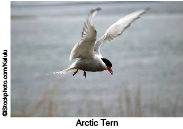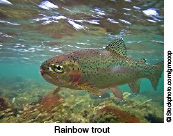



 discussion in 1968 was the Arctic tern, which travels
some 12,000 miles one way as it migrates from the north slope of Alaska
to the southern end of South America and back. At that time experiments
had suggested a number of built-in navigation devices that allow the
terns to make that trip.
discussion in 1968 was the Arctic tern, which travels
some 12,000 miles one way as it migrates from the north slope of Alaska
to the southern end of South America and back. At that time experiments
had suggested a number of built-in navigation devices that allow the
terns to make that trip.
Princeton University researchers recently discovered that the use of magnetism is far more sophisticated than anyone would have guessed in 1968 when we first presented this subject. Dr. Martin Wikelski has shown that birds have light-sensitive cells that sense the magnetic lines of force of the earth in their eyes. In 1998 biologists discovered a protein called cryptochrome in the eyes of many animals. This protein reacts to light in a way that depends on the magnetic field in the place where the animal lives. What is especially interesting is that the cells in most birds' eyes are most efficient with the shorter wavelengths of light. In the fall of the year those shorter wavelengths become more abundant and the bird can navigate more effectively. This also may be a clue the birds use to tell when to begin their migratory journey.
 Researchers have shown that while
some animals use these light-based magnetic detectors, other animals
have small magnetic deposits in various parts of their bodies that give
another way of sensing the earth's magnetic field. Rainbow trout, for
example, have magnetite deposits in their snouts, and pigeons have the
same deposits in their beaks. Dr. Bill Cochran has shown that not only
do some birds have the visual and magnetic methods of navigation, but
they also have ways of setting their magnetic compasses. You can know
the direction of the magnetic field of the earth which points north and
south, but how do you tell which is which? Cochran has shown that some
birds only do their migrating at sunset which tells them that when they
face the sunset, south is to their left and north is to their right.
Researchers have shown that while
some animals use these light-based magnetic detectors, other animals
have small magnetic deposits in various parts of their bodies that give
another way of sensing the earth's magnetic field. Rainbow trout, for
example, have magnetite deposits in their snouts, and pigeons have the
same deposits in their beaks. Dr. Bill Cochran has shown that not only
do some birds have the visual and magnetic methods of navigation, but
they also have ways of setting their magnetic compasses. You can know
the direction of the magnetic field of the earth which points north and
south, but how do you tell which is which? Cochran has shown that some
birds only do their migrating at sunset which tells them that when they
face the sunset, south is to their left and north is to their right.
The complexity of this system and the fact that we are only now beginning to understand all of the different ways animals are designed to use magnetism, testifies to the fact that we can know there is a God through the things He has made (Romans 1:20). As we study birds, whales, fish, bees, monarch butterflies, eels, turtles, and even bacteria we continue to see the evidence of a wonder-working hand that has gone before us.
Reference: The Oklahoman, January 8, 2008, page E1.
Back to Contents Does God Exist?, MayJun09.